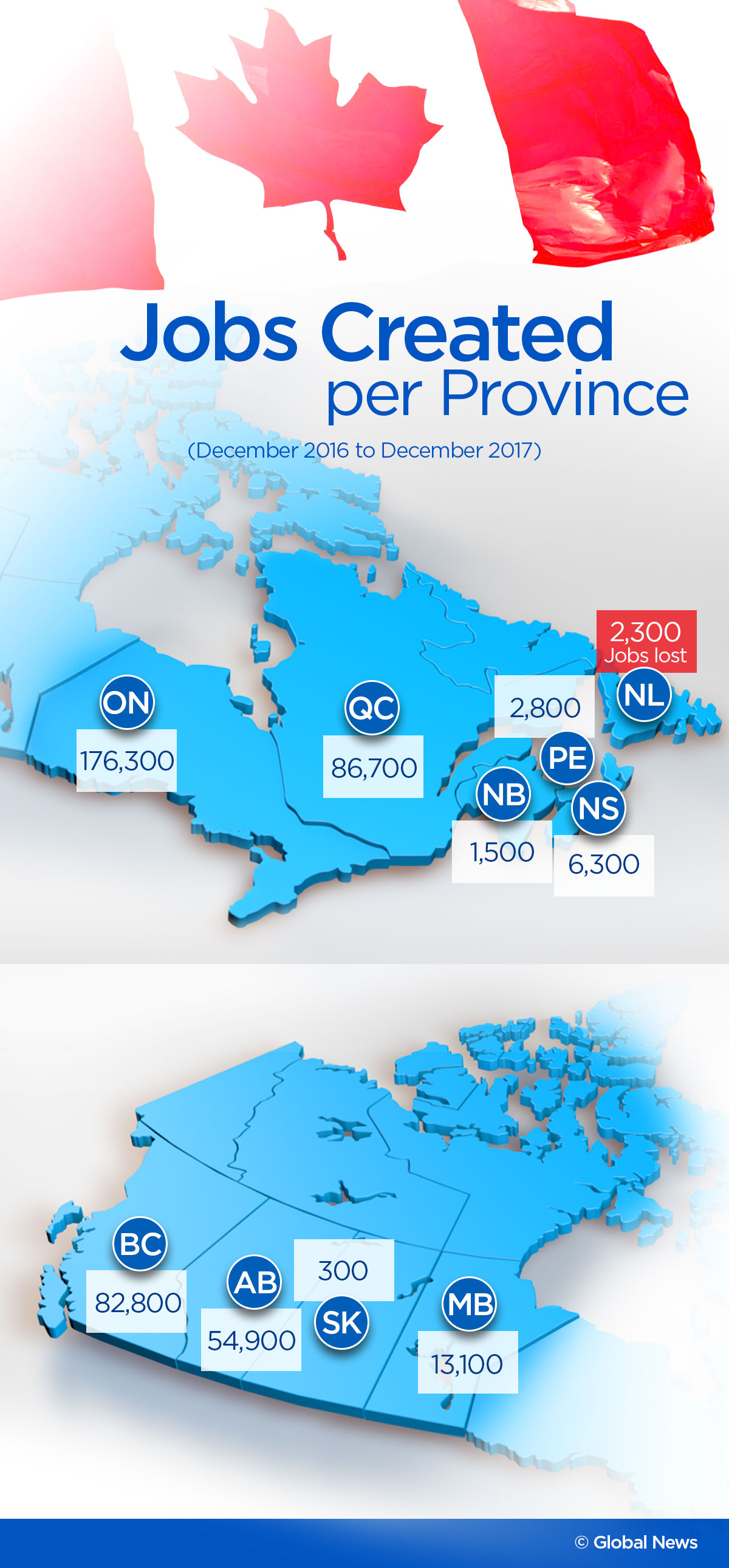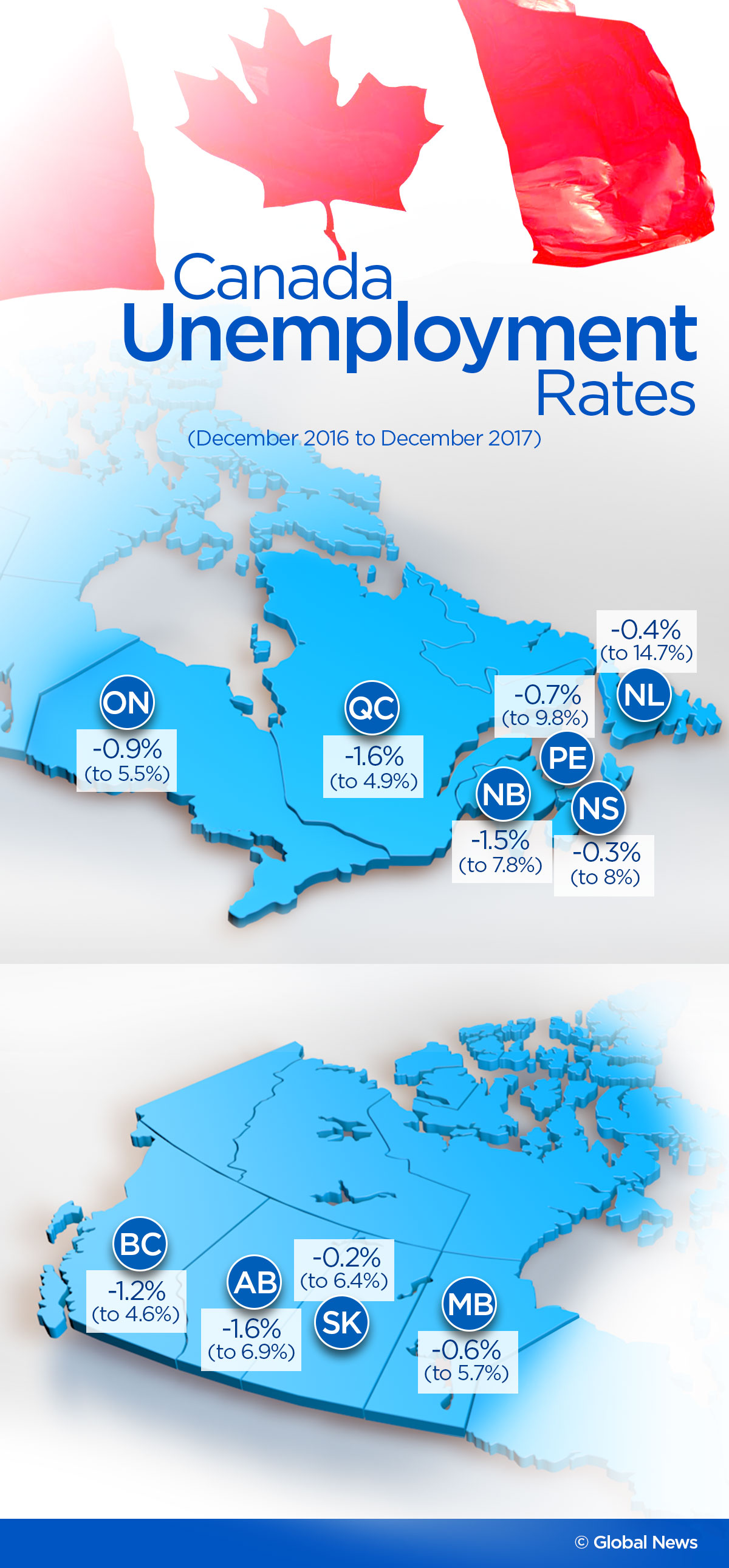Canada’s unemployment rate reached its lowest point in over 40 years in December, according to a labour force survey released by Statistics Canada on Friday morning.

Each Canadian province felt these decreases differently, with some gaining over 26,000 jobs over the course of the month and others still losing more than 2,000.
According to Audra Bowlus, the chair of the department of economics with Western University, decreasing unemployment across the country can often be traced to the stabilization of the Canadian dollar.
WATCH: Canada’s unemployment hits the lowest level since 2008

“The lower dollar now for a substantial period of time has meant that the industry has started investing again,” Bowlus explained.
Below is a provincial breakdown of the jobs created in Canada and industries that were most successful in 2017.
Ontario
Ontario experienced a small decrease in unemployment by approximately 0.9 percentage points, to 5.5 per cent. However, Ontario saw an increase of employment rates by almost three per cent in 2017, which is more than double the province’s growth rate in each of the previous two years, with an additional 176,000 people employed by year end.
- Alberta gig workers push for recognition as unstable incomes, burnout take toll
- Fatal Calgary shooting connected to organized crime, police say
- Extortion suspects have all claimed refugee status, Canada’s border agency says
- Avoid non-essential travel due to snowy, ice-covered roads: southern Alberta RCMP
The primary industries that saw increases include wholesale and retail trade, manufacturing, professional, scientific and technical services, and transportation and warehousing.
Bowlus emphasizes that provinces that see a high volume of part-time jobs added in December should note that this is usually the case due to the holiday shopping season, and likely won’t be sustainable into the new year.
“December is always a period in which part-time employment rates go up. That gain is always there.”
From November to December 2017, full-time work decreased by approximately 13,000 jobs, and over 15,000 part-time jobs were added. Through the rest of 2017 however, the majority of jobs added were full-time.
Quebec

Get breaking National news
In Quebec, increases in full-time work accounted for almost all the 86,700 jobs added in 2017 as the unemployment rate dipped 1.6 percentage points for the year. The province finished the year with an unemployment rate of 4.9 per cent, and added over 26,000 jobs in the month of December alone.
The trend follows a two-year downward pattern, the lowest since comparable data became available in January 1976. Bowlus suspects that the lower Canadian dollar is starting to contribute to this trend in Quebec.
“My understanding of what’s happening in both Quebec and Ontario is that the lower Canadian dollar is starting to see benefits for manufacturers.”
WATCH: Quebec has lowest unemployment rate ever seen

British Columbia
In 2017, British Columbia’s unemployment rate fell by 1.2 percentage points to 4.6 per cent, making it the lowest of all the provinces. The coastal province closed out the year having added over 83,000 new jobs, almost all of which were full-time positions.
The industries that saw the most growth include health care and social assistance, construction, finance, insurance, real estate and leasing. These correspond to the industries that saw increases nationally, which were led by finance, insurance, real estate, and rental and leasing.
The Prairies
While Alberta added over 26,000 jobs in the month of December, Manitoba and Saskatchewan saw modest increases of 700 jobs for the former and 5,000 jobs for the latter.
Following an employment slide in the resources sector between autumn 2015 and the summer 2016, Bowlus explains that recent unemployment numbers indicate that Alberta may be starting to recuperate. Industries in Alberta that saw the greatest increases are manufacturing, wholesale, retail trade, natural resources, finance, insurance, real estate, rental and leasing, transportation and warehousing.
“With the fall in the dollar and the fall in oil prices, they lost the highest number of jobs, against the trend of everybody else. My guess is they’re starting to rebound from that,” said Bowlus.
Saskatchewan on the other hand saw unemployment dip by just 0.2 percentage points during 2017 and added just 300 jobs by the end of the year. Bowlus suspects that following the Alberta resources decline in 2015, former workers in the industry migrated back east, bolstering the unemployment rate in those regions.
“Even if they have seen some employment gains that some of the other provinces have seen, they’re being affected by things happening in other parts of the country,” Bowlus said.
Atlantic provinces
In New Brunswick and Newfoundland and Labrador, unemployment saw little change between 2016 and 2017. Unemployment fell by 1.5 percentage points to 7.8 per cent in New Brunswick, but that was largely due to less workers in the labour market.
Bowlus adds that small decreases in unemployment may actually represent more people being confident enough to actively look for work.
“When things start to improve and they start to see that jobs are available, they will actually come back into unemployment and start looking again,” Bowlus said. It’s important to note that unemployment rates are comprised of individuals who are actively looking for work but are still unemployed.
Nova Scotia on the other hand, added 6,300 jobs in 2017, all in full-time work, though the 8.0 per cent unemployment rate saw little change.
Other highlights
Employment increases in natural resources of over 15,000 followed heavy losses in previous years. Other areas that saw significant employment increases included manufacturing by 86,000, and construction by 51,000.
Furthermore, over 203,000 workers aged 55 and over joined the workforce in 2017 in almost equal parts men and women. Workers aged 65 and over had the greatest year-over-year rate of employment growth in December, rising by 7.8 per cent.
Bowles said that Canadians should also be prepared for some interest-rate policy to come from the Bank of Canada in response to these latest statistics.
“I would anticipate that we would start to see the Bank of Canada look quite seriously at these numbers.”
*No employment data was provided for the North West Territories, Nunavut or Yukon as part of this report.



















Comments